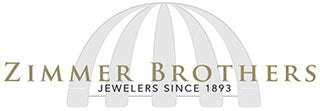The Guide to Diamonds

Diamond Guide
COLOR
Diamonds are found with a range of colors, from light yellow or brown through no color at all, the rarest.
GIA's diamond D-to-Z color-grading scale is the industry's most widely accepted grading system. The scale begins with the letter D, representing colorless, and continues, with increasing presence of color, to the letter Z. Many of these color distinctions are so subtle that they are invisible to the untrained eye; however, these distinctions make a very big difference in diamond quality and price.



Diamond Guide
CUT
The most important characteristic and the only one not determined by nature is what truly separates a superior diamond from an average diamond. Every facet of the diamond and every angle has to be considered as well as the polish and symmetry. The difference in value from an Ideal cut diamond and a below average diamond can be as much as 50%. Every Zimmer Brothers diamond is personally selected and few meet our standards.


Diamond Guide
CLARITY
The fewer imperfections in a diamond, the better. A flawless diamond is EXTREMELY rare and valuable.
Diamond Clarity Refers to the Absence of Inclusions and Blemishes. Natural diamonds are the result of carbon exposed to tremendous heat and pressure deep in the earth. This process can result in a variety of internal characteristics called 'inclusions' and external characteristics called 'blemishes.'
Evaluating diamond clarity involves determining the number, size, relief, nature, and position of these characteristics, as well as how these affect the overall appearance of the stone. While no diamond is perfectly pure, the closer it comes, the higher its value.


Diamond Guide
CARAT WEIGHT
A carat is a measure of weight, which also indicates size. Diamond carat weight is the measurement of how much a diamond weighs. A metric "carat" is defined as 200 milligrams.
Each carat can be subdivided into 100 'points.' This allows very precise measurements to the hundredth decimal place. A jeweler may describe the weight of a diamond below one carat by its 'points' alone. For instance, the jeweler may refer to a diamond that weighs 0.25 carats as a 'twenty-five pointer.' Diamond weights greater than one carat are expressed in carats and decimals. A 1.08 carat stone would be described as 'one point oh eight carats.'
*Information and imagery provided by GIA Association (www.GIA.edu)

